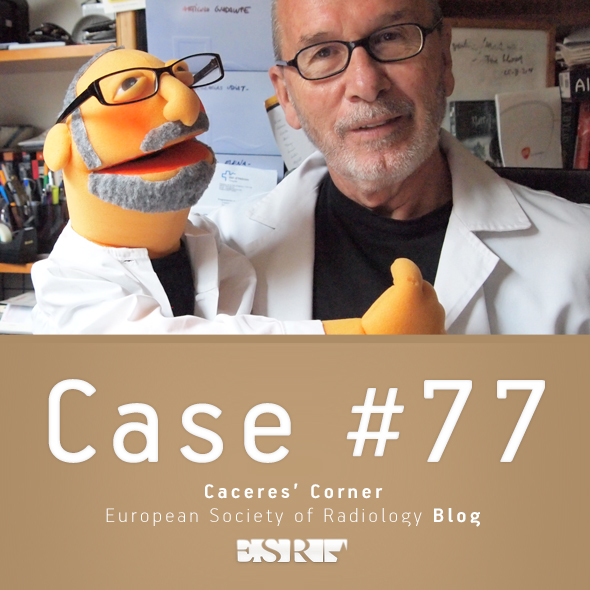
B-0576 Imaging features of acinar cell cystadenoma: can we differentiate them from branch duct IPMNs?
C. Delavaud, G. D’Assignies, J. Cros, P. Ruszniewski, P. Hammel, A. Couvelard, V. Vilgrain, M.-P. Vullierme
Purpose: Acinar cystic cystadenoma (ACC) of the pancreas is a rare benign entity first described in 2002, defined by histological criteria. Radiographic appearance had almost not been described so far. Most of the patients underwent surgical resection under the preoperative diagnosis of intraductal papillary mucinous neoplasms. The aims of this study are to define imaging diagnostic criteria of ACC based on radiopathological confrontation and to compare clinical, biological and imaging data between patients with ACC and with branch ducts IPMN.
Methods and Materials: All patients with ACC who underwent pancreatic surgery for suspicion of IPMN and the 20 last patients with histologically proven branch ducts IPMN were retrospectively included. Clinical and biological information were collected from the medical reports. Radiological and histological documents were reviewed in order to define imaging diagnostic criteria of ACC. Data were compared using the Chi-square test or Fisher’s exact test.
Results: ACC was symptomatic in all but one patient. There were no statistical difference between ACC and IPMN group with regard to clinical and biological data. Combination of four radiological criteria allowed differentiating ACC from IPMN: cyst calcification, presence of more than 5 cysts, clustered peripheral small cyst, and absence of communication with main pancreatic duct. Sensibility and specificity were, respectively, 75 and 100 % with combination of at least three of these criteria.
Conclusion: ACC is a rare benign pancreatic tumour with specific imaging features despite some similarities with IPMN. Recognition of this entity may help us to propose the diagnosis and prevent extensive surgery.

Dear Friends,
Presenting the case of a 45-year-old man with fever, one week after coronary surgery. I apologise for the poor quality of the PA radiograph, but it does not influence the diagnostic evaluation.
Check the images below and leave your opinion in the comments. The answer will be posted on Friday.
Diagnosis:
1. Pericardial fluid
2. Pleural fluid
3. Both
4. Anything else
Read more…

B-0188 Dynamic contrast-enhanced MRI can assess vascularity within pseudarthrotic clefts and predicts good clinical outcome
M.-A. Weber, K. Bloess, I. Burkholder, D. Bender, G. Schmidmaier, H.-U. Kauczor, O. Schoierer | Thursday, March 7, 14:00 – 15:30 / Room E1
Purpose: To prospectively evaluate whether dynamic contrast-enhanced (DCE) MRI can assess vascularity within pseudarthrotic clefts and predicts clinical outcome better than the clinical non-union scoring system (NUSS).
Methods and Materials: Sixty-four patients (mean age, 49.3 years) with non-union of an extremity fracture in computed-tomography received 3-Tesla MRI including DCE (coronal T1-weighted fat-saturated VIBE, TR/TE=3.76/1.35ms, 17 measurements, 2 mm slice thickness) after 0.1mmol/kg body-weight of gadoterat. We assessed vascularity within the pseudarthrotic cleft using a region-of-interest analysis. Signal intensity curves were subdivided into those with more intense contrast-agent uptake in the pseudarthrotic cleft than in normal adjacent muscle tissue (vascularised non-union) and those with similar or less uptake. The pharmacokinetic parameters of the Tofts model (Ktrans, Kep, iAUC, Ve) were correlated to the clinical outcome at one-year follow-up (n=37).
Results: Despite inserted osteosynthesis material, DCE parameters could be evaluated in n=60 at first visit. Sensitivity/specificity of vascularised non-unions as indicator of good clinical outcome was 77.3%/46.7% compared to 95.5%/26.7% using NUSS. Logistic regression revealed non-significant impact of NUSS on clinical outcome (p=0.27, odds ratio=0.97). At first examination, median iAUC (initial area under the enhancement curve) was 24.13 in patients with good outcome compared with 10.96 in non-responders (p=0.032), while Ktrans, Kep, and Ve were not significantly different. Using a receiver operating characteristic analysis, sensitivity/specificity of iAUC at the optimal cut-off value of 17.5 to predict outcome was 68.2%/76.9%. All pharmacokinetic parameters did not change significantly at the one-year control (n=18).
Conclusion: DCE MRI can assess vascularity in pseudarthrotic clefts. A vascularised non-union indicates good clinical outcome.

B-0406 Increased regional grey matter volume in Parkinson’s disease patients with excessive daytime sleepiness: an MRI study
L.C. Tzarouchi, M. Chondrogiorgi, A. Zikou, P. Kosta, M.I. Argyropoulou, S. Konitsiotis | Friday, March 8, 14:00 – 15:30 / Room B
Purpose: Excessive daytime sleepiness (EDS) is an important non-motor symptom of Parkinson’s disease (PD). The underlying neuropathological mechanism accounting for EDS is not well understood. The purpose of the present study was to determine regional grey matter (GM) volume changes in PD patients with EDS.
Methods and Materials: Seventeen PD patients with EDS (Epworth Sleepiness Scale ESS ≥ 12) (EDS-PD), 17 age and disease duration-matched PD patients (Epworth Sleepiness Scale ESS ≤ 6) and 17 age-matched healthy controls were enrolled in the study. The χ2 and Student’s t tests were used to test for differences in demographic and clinical characteristics between groups. Differences in GM volume between groups were evaluated by applying the voxel-based morphometry (VBM) method.
Results: Total calculated levodopa equivalent dose was higher in EDS-PD when compared to PD patients (p<0.05). Comparison of EDS-PD with PD patients and controls showed increased GM volume bilaterally in the hippocampus, the parahippocampal gyrus, the fusiform gyrus and in cortical areas in the temporal, frontal and parietal lobes (p<0.001).
Conclusion: EDS-PD patients present increased regional GM volume in the mesolimbic/mesocortical dopamine pathway, which is activated during sleep. Drug-induced GM volume increase through a process of neuronal plasticity may represent the underlying mechanism.

Dear Friends,
This week I am presenting radiographs of a 78-year-old male with haemoptysis. Have a look at the images below and leave us your thoughts and diagnosis in the comments section. The answer will be added on Friday.
Diagnosis:
1. Hydropneumothorax in minor fissure
2. Tuberculosis
3. Carcinoma
4. None of the above
Read more…

A-224 C. Metabolic disorders
J.F. Schneider | Saturday, March 9, 08:30 – 10:00 / Room E2
Metabolic disorders may present at any age. Their clinical symptoms are often scarce or non-specific. Brain MRI is often used in the setting of an acute illness but may be delayed in slowly progressive disease. Imaging appearance can be confusing as acute and chronic signal intensity alterations may overlap in many disorders. Furthermore, imaging appearance will vary during the course of the disease. Recognition of signal changes in specific structures is most helpful in the acute setting before chronic changes set in, which will blur characteristic patterns. A systematic approach based on the pattern of brain involvement is useful in the analysis of neurometabolic disorders, and has even been computerized. First, a decision whether grey or white matter involvement or both must be made based upon volume and signal alterations on T1-wi, T2-wi, FLAIR imaging and contrast enhancement. Second, alterations within either focal grey matter structures or specific white matter tracts must be recorded and estimation upon their timing, whether acute or chronic, must be made. Finally, this pattern recognition must be supplemented by microstructural data from diffusion-weighted images (DWI) and metabolic data from proton MR spectroscopy (MRS). Additional information from DWI is often restricted to the acute setting, because chronic diffusivity changes are mainly driven by unspecific myelin breakdown. On the other hand, MRS may not only identify abnormal levels of normal metabolites or demonstrate the presence of abnormal metabolites, but can also be used to monitor therapy.

B-0323 Apparent diffusion coefficient for evaluating early tumour response to neoadjuvant chemo-radiotherapy in locally advanced cervical cancer: correlation with histopathology. Preliminary results
M. Iacobucci, M. Miccò, A.L. Valentini, B. Gui, A.M. De Gaetano, L. Bonomo | Friday, March 8, 10:30 – 12:00 / Room F1
Purpose: To evaluate diagnostic accuracy of diffusion-weighted magnetic resonance imaging (DWI) in predicting response to neo-adjuvant chemo-radiotherapy (nCRT) in patients with locally advanced cervical carcinoma using apparent diffusion coefficient (ADC). Cervical lesions ADC were correlated with post-surgical histopathology.
Methods and Materials: 24 women (FIGO>IB Bulky) underwent MRI and DWI prior to, after 2 weeks and at the end of nCRT, using 1.5 T scanner. Cervical lesion volume and ADC were measured at each assessment. Radical hysterectomy was performed 4 weeks after MRI. Treatment response was determined based on histopathology and was classified as complete response (CR), residual (RD) or stable disease (SD). Mean ADCs (mADC), ADC increase and volume reduction (VR) rates were compared using histopathology as reference standard
Results: According to histology, 13/24 (54%) had CR, 11/24 (46%) had RD <1 cm. 2 patients presented SD. Before therapy, in the study population mADC was 0.96±0.06×10-³ mm²/s but it was lower in SD (0.76±0.1×10-³ mm²/s). After 2 weeks of nCRT, mADC correlated with tumour response: a) in CR with 23 % percent change (1.20±0.02×10-³ mm²/s vs 0.98±0.06×10-³ mm²/s; P<0.001); b) in RD with 10 % percent change (1.05±0.02×10-³ mm²/s vs 0.93±0.06×10-³ mm²/s; P<0.001). Tumour volume decreased in CR and RD with reduction rate of 48 % and 46 %, respectively. At the end of CRT, no significant differences on ADC between CR and RD (mADC 1.20±0.07×10-³ mm²/s vs 1.17±0.06×10-³ mm²/s; P>1) were observed. All CR had local inflammation at histology.
Conclusion: ADC is early indicator of tumour response in patients with advanced cervical cancer.

B-0297 Non-solid, part-solid or solid? Classification of pulmonary nodules in thoracic CT by radiologists and a computer-aided diagnosis system
C. Jacobs, E.M. van Rikxoort, J.-M. Kuhnigk, E.T. Scholten, P.A. de Jong, C. Schaefer-Prokop, M. Prokop, B. van Ginneken | Friday, March 8, 10:30 – 12:00 / Room D1
Purpose: Classifying pulmonary nodules into solid, part-solid and non-solid is crucial for patient management. A computer algorithm is compared to a radiologist on a large data set obtained from a multi-center lung cancer screening trial.
Methods and Materials: Low-dose chest CT scans (16×0.75mm, 120-140 kVp, 30 mAs) with part-solid, non-solid, and solid nodules with a diameter between 7 and 30 mm were randomly selected from two sites participating in the Dutch-Belgian NELSON lung cancer screening trial. The set contained 137 scans, including 50 part-solid, 50 non-solid and 52 solid nodules. The nodule-type recorded in the screening database was used as a reference standard. An automated classification system for characterization of nodules was designed using morphometric features. The accuracy of the computer algorithm was evaluated in three ways: classifying nodules (1) as solid or subsolid, (2) as solid, part-solid or non-solid, and, (3) for the subsolid lesions only, as part-solid or non-solid. An experienced thoracic radiologist independently performed the same classification.
Results: The accuracy of the automated system to differentiate between solid and subsolid nodules was 0.88, compared to 0.95 for the radiologist. The computer classified the nodules as solid, part-solid or non-solid with an accuracy of 0.72 versus 0.80 for the radiologist. The software reached an accuracy of 0.71 in differentiating part-solid from non-solid nodules, where the radiologist had an accuracy of 0.77.
Conclusion: A novel automated characterization tool for pulmonary nodules shows promising performance and could aid radiologists in selecting the appropriate workup for pulmonary nodules.

Dear Friends,
Today I’m presenting radiographs of a 54-year-old male with chest pain (below).
Would you call these radiographs normal?
If not, where is the abnormality?
Leave me your answers in the comments section and look out for the answer on Friday.
Read more…

A-339 Chairman’s introduction
M. Krokidis, A.A. Hatzidakis | Saturday, March 9, 16:00 – 17:30 / Room N/O
There are some basic IR techniques everybody needs to know before starting to treat biliary diseases. Τhese are Percutaneous Transhepatic Cholangiography (PTC) and Percutaneous Transhepatic Biliary Drainage (PTBD). These basic procedures are essential first for opacification and then for getting access into the biliary tree. After accessing the biliary system, decisions must be made about the need for further interventional procedures. Presence of benign or malignant strictures, stones or other kind of disease are leading us to the necessary actions, such as dilatation, stenting or lithotripsy. Dilatation of stenosed parts of the biliary system is performed after negotiation of the stricture or occlusion with help of high-pressure angioplasty balloons of variant sizes. Balloons of 8-14 mm width can be used alone or two parallel to each other. Stenting is rarely needed in benign biliary disease and usually in cases where multiple dilatations are not responding. Percutaneous lithotripsy with or without cholangioscopic assistance is a wide-used technique for clearance of biliary stones or fragments. Extraction balloons or baskets and special lithotripsy devices are commonly used for impacted or large calculi.









